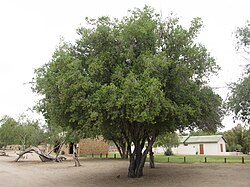| Pappea | |
|---|---|
 | |
 | |
| Scientific classification | |
| Kingdom: | Plantae |
| Clade: | Tracheophytes |
| Clade: | Angiosperms |
| Clade: | Eudicots |
| Clade: | Rosids |
| Order: | Sapindales |
| Family: | Sapindaceae |
| Subfamily: | Sapindoideae |
| Genus: | Pappea Eckl. & Zeyh. |
| Species: | P. capensis |
| Binomial name | |
| Pappea capensis | |
Pappea capensis is a South African tree in the family Sapindaceae. It is the only species in the genus Pappea. [1]


